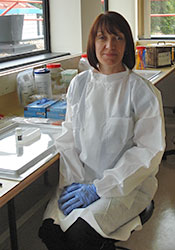What challenges do you face in the next few months?

Our biggest challenge now is to be able to improve our testing procedures following the increase in the number of samples that we receive daily. This means trying to streamline the steps involved and to implement automation and robotics in many areas of the process, wherever we can in the lab, to aid the high through-put of more samples.
In the winter, we expect to see a further increase in testing, as seasonal influenza may circulate as well. We are also involved in vaccine trials for the future pandemic (H1N1) virus vaccine, and in many studies looking at different aspects of the infection and treatment, for which we will have to adapt our way of working and try to find resources.
Learning from what happens in the Southern Hemisphere: Dr Meijer
The big challenge over the coming months will be to monitor how the pandemic evolves. As seasonal influenza takes hold in the Southern Hemisphere, we need to watch carefully and consider what we can learn from this.
Needing more time and qualified staff: Dr Mironenko
I expect that the autumn will be even more challenging, with more work for us and panic among the general public, and even medical personnel. We will need more specialists – epidemiologists and virologists – in the lab.
Seasonal surveillance testing on top of pandemic testing: Dr Ciblak
We have an increasing number of samples sent to the laboratory for testing. At some point we have to have a policy and be selective about the samples that we test. We could also start receiving seasonal surveillance samples for testing in addition to the pandemic samples we receive now. I am also worried that, as we buy all our testing materials from abroad, at some point we could run out of reagents.



